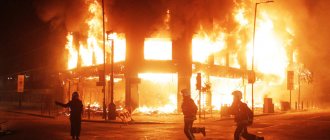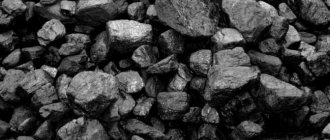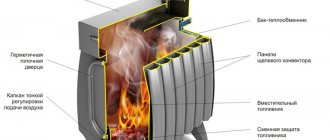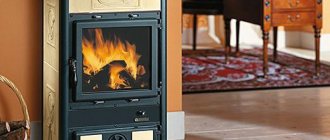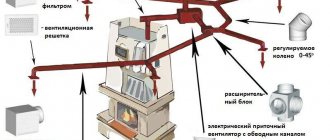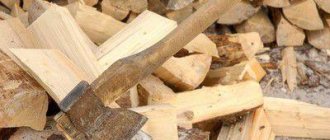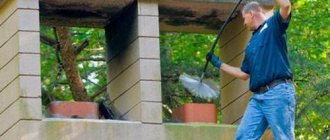What kind of firewood is best for the stove? Calorific value of firewood from various types of wood
In fact, in any house located outside the city there is such a mandatory attribute as a stove. You can cook on it, and it also warms your home, thus helping to create a positive atmosphere in the winter. But sometimes boilers that run on different types of fuel are used for heating. At the same time, a legitimate question often arises: what kind of firewood is best for the stove?
Any owner of private property tries to look for fuel at a suitable price. Gas in this regard is considered an excellent replacement, but it is not available in all areas. Electrical energy is available all the time, but it does not fit into the heating system due to the low power of the equipment and the high final price.
Thanks to this, wood stoves have been and continue to be a cost-effective solution with many positive characteristics. A high degree of heat transfer, ease of operation and firewood, the price of which is relatively low. When the water heating system is not used, it will have to be preserved, and this process is not so simple. There are simply no problems of this kind with the stove.
Even if the heating system includes equipment that runs on gas or coal, it is impossible to completely do without firewood. Some connoisseurs of coziness and comfort have a fireplace at home. And to maintain health, there is one excellent and proven remedy - a bath!
But, returning to the questions of which firewood is best for a stove, bathhouse or fireplace, you need to know about their varieties. The amount of heat released during combustion depends on how dense and hard the logs are. Knowing which firewood is highly efficient for heating a home, you can significantly save on fuel.
People have been using wood for a very long time to make fire, which has long served any purpose: it gave warmth, helped cook food, and scared away unwanted guests. Some trees burn better, producing a lot of heat, while others are poorly suited for heating and emphasize soot during the combustion process. Because of this reason, there are types of firewood that are ideal for heating a house or lighting a bathhouse. The rest are best placed in the fireplace.
Quite popular tree species are:
All firewood is varied, and it’s not that some types are better than all others. Each of them has pros and cons. Let's look at them in more detail, but first a few words about the calorific value of firewood from various types of wood.
What is the combustion process
An isothermal reaction in which a certain amount of thermal energy is released is called combustion. This reaction goes through several successive stages.
In the first stage, the wood is heated by an external fire source to the ignition point. As it heats up to 120-150 ℃, the wood turns into coal, which is capable of self-ignition. Once the temperature reaches 250-350 ℃, flammable gases begin to be released - this process is called pyrolysis. At the same time, smoldering of the top layer of wood occurs, which is accompanied by white or brown smoke - these are mixed pyrolysis gases with water vapor.
At the second stage, as a result of heating, the pyrolysis gases ignite with a light yellow flame. It gradually spreads over the entire area of the wood, continuing to heat the wood.
The next stage is characterized by ignition of the wood. As a rule, for this it should warm up to 450-620 ℃. For wood to ignite, you need an external heat source that is intense enough to rapidly heat the wood and speed up the reaction.
In addition, the rate of firewood ignition is influenced by factors such as:
- craving;
- wood moisture;
- cross-section and shape of firewood, as well as their quantity in one stack;
- wood structure - loose firewood ignites faster than dense wood;
- placement of the tree relative to the air flow - horizontally or vertically.
Let's clarify some points. Since wet wood, when burning, first evaporates excess liquid, it ignites and burns much worse than dry wood. Shape also matters—ribbed and jagged logs ignite more easily and quickly than smooth, round ones.
A couple of phrases about calorific value
In terms of its chemical composition, wood is a complex material. It contains key elements - lignin and cellulose. However, in addition to them, the tree contains:
- resins;
- proteins;
- tannins and other components.
When firebrands ignite in a stove (or simply when trees burn in the wilderness), such components interact with the air at a chemical level. The calorific value of wood (like any fuel), or heat conductivity, is the amount of heat energy that a unit of weight of the fuel material (in our case, 1 kg of wood) produces during combustion. To measure quantities, kilocalories are used.
The chemical composition of a large number of tree varieties has the smallest fluctuations, which causes differences in the number of calories emitted. In other words, the heat of combustion of many types of firewood can be as follows:
- for deciduous species the figure is 4460 kcal/kg;
- for coniferous species - 4560 kcal/kg;
- for mixed breeds – 4510 kcal/kg.
As you may have noticed, the differences are minimal. At the same time, it is easy to understand that it is better to use coniferous wood for the stove due to its greater thermal conductivity. Firewood is supplied exclusively to the market depending on volume, not weight. In other words, the main parameter for choosing firewood is cubic meters. Density plays a major role here, because the higher it is, the heavier the wood.
For example, let’s take 1 cubic meter of birch firebrands as a starting point. Then the ratio of the volume of different rocks will look like this:
- oak logs? 0.75 cu. m;
- alder logs? 1.1 cu. m;
- pine logs? 1.2 cu. m;
- spruce logs? 1.3 cu. m;
- aspen logs? 1.5 cu. m.
In other words, 1 cubic meter of birch and 0.75 cubic meters. m of oak firebrands, 1.1 cubic meters. m of alder wood (and so on) will produce the same amount of heat. Knowing this, now, depending on how much firewood costs, you can get cost-effective savings for yourself.
Density of wood and its effect on calorific value
In addition to moisture content, another factor affects the calorific value of firewood, namely density. This is a common physical quantity that shows how much weight a substance has per standard volume (usually per cubic meter).
To estimate calorific value, you need to use a slightly different characteristic, namely specific calorific value, which is a value derived from density and calorific value.
Information on the specific calorific value of certain wood species was obtained experimentally. The information is given for the same humidity level of 12 percent. Based on the results of the experiment, the following table :
Using the data from this table you can easily compare the calorific value of different types of wood.
Softwood firewood: pine, spruce, larch
By the distinctive crackling of firebrands, which literally caresses the ear, and the light scattering sparks, you can determine the burning of pine firebrands. They give off a lot of heat, but burn out quite quickly. However, many of the disadvantages are quickly forgotten thanks to the exclusive resinous aroma that comes from burning pine or spruce firewood. In this case, you must be extremely vigilant, because the sparks that sometimes shoot out can cause a lot of trouble. Because of this, you need to follow safety precautions.
It must be said that pine logs produce more heat than spruce logs. In most cases, due to the high content of resinous substances, through which the above-mentioned odor is released. Pine and spruce, it creates an equally invigorating effect. In addition, it can have a tonic effect on the organs of the upper respiratory tract. Moreover, spruce logs have a “shooting” effect, while pine firewood has a smoke effect. But the wood of both species easily splits and melts, although it smokes heavily.
As for larch, it is not often that people use such firewood to light a combustion chamber due to its low popularity. It is necessary to take into account that when firebrands burn, carbon monoxide is released in large quantities. Because of this reason, there is no need to immediately close the damper, and in a house outside the city or country cottage there should be a good ventilation system.
Birch - traditions should not be broken
Many people are inclined to believe that such firewood is the optimal fuel for starting a fire in a fireplace, stove or sauna. And all due to priceless positive qualities:
- easy to light;
- burn for a long time;
- the flame comes out attractive and even;
- no sparks;
- rich heat dissipation.
But the positive qualities don't end there. The medicinal properties of birch have long been known. A good smell has a good effect on the human body, protecting it from colds and chronic ailments. In other words, birch firewood has a disinfecting effect, which causes agreement among fans to take a steam bath.
When ignited, logs release a small amount of carbon dioxide, and this is undoubtedly a plus. But there is also a minus - a large concentration of tar. And this combustion product is no longer beneficial to health. In addition, soot and soot appear on the walls of the stove and in the chimney. As a result, over time, not only will traction be lost, but the risk of fire or carbon monoxide poisoning will increase. Therefore, when choosing such firewood, it is also worth learning the profession of a chimney sweep, and also practicing safety.
But, despite its inherent disadvantages, birch is a fairly popular, affordable and practical fuel.
How to determine the combustion temperature in a wood-burning stove
Measuring the combustion temperature of wood in a fireplace can only be done with a pyrometer - no other measuring instruments are suitable for this.
If you do not have such a device, you can visually determine approximate indicators based on the color of the flame. Thus, a low temperature flame has a dark red color. A yellow light indicates that the temperature obtained by increasing the draft is too high, but in this case more heat is immediately evaporated through the chimney. For a stove or fireplace, the most suitable combustion temperature will be one at which the color of the flame will be yellow, such as, for example, dry birch firewood.
Modern stoves and solid fuel boilers, as well as closed fireplaces, are equipped with an air supply control system to adjust heat transfer and combustion intensity.
Alder - a royal gift
If you just want to feel like a member of the king’s family, it’s worth getting hold of alder logs, because it’s not for nothing that people call them royal logs. They flare up quickly, emphasizing just a large amount of heat, practically no smoke appears, which also eliminates the occurrence of soot and soot. In addition, the logs burn for a very long time. In other words, the question of what kind of firewood is best to heat the stove in the house has already been resolved!
But the most important piquancy lies in the original aroma, which has a healing effect. It has long been accepted that if you heat a bathhouse using alder wood, you can once and for all forget about colds. In addition, even in the old days, alder logs were placed in the royal furnaces, as well as in the combustion chambers of other estates of poor peasants or nobles.
Freshly cut alder of a red-orange hue, thanks to which the woodpile has an original and light appearance. There is one interesting feature that everyone should know about. All the advantages described apply to trees that grew in dry areas. If the plants bloomed in the swamp, then there will be soot and unbearable heat.
Alder is very popular among fans of smoking meat or fish. Under traditional conditions, wood dries very quickly, and it retains its own healing natural properties for 3 years.
Oak - fortress of spirit
Which firewood takes the longest to burn? Undoubtedly oak! They are distinguished by their great strength and density. It’s not for nothing that experts jokingly classify this breed as an elite variety, and only then it is valued as a type of fuel. Due to these properties, oak logs maintain heat at the required level, give strong heat, and the negative impact of various external factors does not in any way affect them.
The smell emanating from the firewood is so pleasant, tart and soft that you can feel the breath of the forest expanses. Like birch, oak can have a beneficial effect on the human body, especially on the psyche. Also promotes relaxation and improves immunity.
The tree is considered to have a long life, and it is not very easy to find wood suitable for kindling. Not just any logs are suitable for this. Firewood from young plants will not produce much heat, but when burning old ones, a decent amount of ash is formed, the air becomes excessively heavy - not every bathhouse guest will be able to withstand it.
Home heating with wood from middle-aged trees is excellent - they provide as much heat as necessary, and even more. But they are quite difficult to find, so oak is used quite rarely as a fuel, and it also grows more slowly.
For reference: once upon a time, good and strong ships were built from oak. Nowadays it is believed that truly tasty and juicy pizza can only be prepared using oak wood. They are also more suitable for lighting a fireplace, the only problem is that such wood is difficult to split.
Fruit trees for flavor
Of course, no one will grow fruit trees for the sole purpose of using them for firewood. However, there is still an apple, pear, plum or cherry tree on the site. Over the course of some time, you can collect a lot of branches and twigs, which you can put into the combustion chamber. Some people start fires right away, but it would be better to carefully cut them and put them in a woodpile. They are more suitable for lighting a bathhouse, since along with excellent and even heat, the combustion of wood produces light steam accompanied by a pleasant, delicate aroma.
Cutting and splitting firewood does not cost anything; the apple tree is considered the leader in terms of heat release, and there is almost no smoke. But such a choice is rather beautiful in nature.
Aspen – cleaning firewood
Aspen also takes a long time to light and burns quickly. Thanks to this, it is not necessary to heat the stove with such firewood, as they say, “from scratch.” At the same time, the flames are long and light. There are also some other valuable properties. In addition to the fact that firewood itself does not create soot, it can remove soot that appears from other firebrands. In addition, in comparison with birch firewood, aspen logs produce much less heat when burning.
But they can be used to “clean” the chimney. For this purpose, it is recommended to add several aspen firewood at the final stage of the combustion chamber. And the chimney will be “cleaned”. Although they themselves do not produce heat, they are able to maintain heat for a very long time.
Light willow logs
If you come across willow firewood in your field of vision, you shouldn’t refuse them. The heat from them is great, the flame is even, and on top of that, there is no soot. The only negative is that they burn out very quickly. But this is easily offset if there are a large number of willow trees in the area of residence. Many landscaping companies do not give them enough time to form. Old trunks are cut down, and branches are removed from still young trees. So don’t miss any opportunity to profit from such fuel for your own home, bathhouse or fireplace.
As is clear, there are too many types of wood, and to list all their types, you could write a thick book, or even more than one.
Because of this, in addition to these varieties, it is worth mentioning at least a few more:
- Elm. It produces a lot of smoke, does not crack well and requires a lot of time to ignite.
- Poplar. Like firewood for a stove - quite nothing. They prick without problems, they just scatter sparks and burn quickly.
- Beech. It is also difficult to burn and split, but it is possible to use it raw.
- Fir. Like poplar, it splits and ignites easily, but it can hardly be done without a decent amount of smoke and sparks.
- Sycamore. Wood is easy to kindle, but difficult to split.
Can they be used for the combustion chamber in a furnace? Everyone can find the answer to this question themselves. But, on the other hand, why not?!
Heat output of wood
In addition to the value of calorific value, that is, the amount of thermal energy released during fuel combustion, there is also the concept of heat output. This is the maximum temperature in a wood-burning stove that the flame can reach when the wood is burning intensely. This indicator also completely depends on the characteristics of the wood.
In particular, if the wood has a loose and porous structure, it burns at fairly low temperatures, producing a light, high flame, and produces fairly little heat. But dense wood, although it flares up much worse, even with a weak and low flame gives a high temperature and a large amount of thermal energy.
This must be remembered!
Regardless of the type of trees that will be used for firewood, it is important to know about some specifics:
- Deadlines. Undoubtedly, those logs that have already spent their “allotted” period of time will burn (provided that they are dry and there is no mold on them). However, most trees retain their own scent for only 2 years. Alder and aspen are a pleasant exception in this regard - 3 years.
- Everything has its time. In winter, the humidity of trees is at a minimum level. Therefore, wood procurement should be done at this stage. Drying in most cases takes about 12 months. However, the timing depends on the type of forest, harvesting time, saving options and a number of other factors. In this case, the duration may increase significantly or, conversely, decrease.
- Dimensions. What kind of firewood is profitable? Of course, those with good sizes. And this is 40-50 cm in length and 8-10 cm in thickness. So they are comfortable to store and suitable for any combustion chamber.
- Rot. Just don't use rotten wood. Prolonged exposure of firebrands to the ground results in the accumulation of toxic substances released during fire, which is not beneficial to humans. Because of this reason, when cutting down branches, you must immediately take the correct measures to store them. When selecting raw materials for the combustion chamber among dead wood, you should not take into account long-fallen branches.
- Storage issues. Logs should be laid with the bark facing up. This will make it possible to protect the firewood from accidentally entering moisture, which quickly erodes from the surface of the bark. And if you show your imagination, you can build an unusual woodpile to the delight and amazement of your guests.
As you can see from this material, it’s not enough to know which firewood is best for the stove. No less important is the impeccability of their storage.
Regarding the improvement of the woodpile, you can always come up with a lot of very different ideas: from the most creative and crazy to the most ordinary in implementation.
How does draft in a stove affect combustion?
If an insufficient amount of oxygen enters the furnace firebox, the intensity and temperature of wood combustion decreases, and at the same time its heat transfer decreases. Some people prefer to cover the ash in the stove to extend the burning time of one bookmark, but as a result, the fuel burns with lower efficiency.
If wood is burned in an open fireplace, then oxygen freely enters the firebox. In this case, the draft depends mainly on the characteristics of the chimney.
Under ideal conditions, the formula for a thermochemical reaction looks something like this:
This means that when oxygen is available, hydrogen and carbon are burned, resulting in thermal energy, water vapor and carbon dioxide.
For the maximum combustion temperature of dry fuel, about 130% of the oxygen required for combustion must enter the furnace. When the inlet dampers are closed, an excess of carbon monoxide is produced due to a lack of oxygen. Such unburnt carbon evaporates into the chimney, however, the combustion temperature inside the firebox drops and the heat transfer of the fuel is reduced.
Modern solid fuel boilers are often equipped with special heat accumulators. These devices accumulate an excessive amount of thermal energy generated during the combustion process of fuel under conditions of good traction and high efficiency. This way you can save fuel.
In the case of wood-burning stoves, there are not many opportunities to save wood, since they immediately release heat into the air. The stove itself is capable of retaining only a small amount of heat, but an iron stove is not capable of this at all - excess heat from it immediately goes into the chimney.
Thus, by increasing the draft in the furnace, it is possible to achieve an increase in the intensity of fuel combustion and its heat transfer. However, in this case, heat loss increases significantly. If you ensure slow combustion of wood in the stove, then its heat transfer will be less, and the amount of carbon monoxide will be greater.
Please note that the efficiency of the heat generator directly affects the efficiency of wood burning. Thus, a solid fuel boiler boasts 80% efficiency, and a stove – only 40%, and its design and material matter.
Folk tales
Superstitions and beliefs circulate among the people. For example, it is believed that it is better to collect wood for a bathhouse during the waning moon. Moreover, the thinner the sickle, the stronger the logs are endowed with healing powers. A very long time ago, the Slavs thought that people who left the world turned into maples in their own lives. The appearance of its leaves is like open palms, and its branches represent arms raised to the heavens. Because of this reason, they never fired maple stoves.
In the old days, residents of the Tambov province heated their stoves exclusively with apple trees in order to keep the house warm throughout the winter, including especially frosty days. Whether to trust all this or not is everyone’s business, but what happened was what happened. What do you, not cheap readers, think: what kind of firewood is better for a stove, bathhouse or fireplace?
Main criteria
The most basic indicators for combustion material: density, humidity and heat transfer. They are all closely related to each other and determine to what extent wood burning is considered practical and useful. It is necessary to consider any of them in more detail, taking into account the various types of wood and methods of its preparation.
Firstly, what the right consumer pays attention to when ordering wood heating material is its density. The higher this indicator, the higher quality the breed is considered.
All tree species are divided into three key categories:
- low-density (soft);
- medium-dense (moderately hard);
- high-density (solid).
We recommend reading the publication about what types of firewood there are. Plus everything about this material.
Categories of wood varieties according to their density (kg/m3)
Each of them has a different density, which means the specific heat of combustion of wood. Hard varieties are considered the highest quality. They burn longer and bring out more heat. They also create a lot of coals, which keep the combustion chamber hot.
We suggest you learn information about how to chop wood correctly on this site.
Due to its own hardness, such firewood is difficult to finish, which is why some consumers prefer medium-density wood, for example, birch or ash. Their structure makes it possible to chop logs manually without much effort.
The second indicator is humidity, in other words, the percentage of water content in the wood structure. The higher this value, the greater the density, while the resource used will generate less heat with the same effort expended.
The specific heat of combustion of dry birch firewood is more productive than wet wood. It is necessary to note this characteristic of birch: it can be placed in the combustion chamber almost immediately after felling, because it is distinguished by moderate humidity. To maximize the beneficial effect, it is better to prepare the material appropriately.
The relationship between the drying level of firewood and its density for a wide variety of species
To increase the quality of wood by reducing the percentage of moisture content in it, these approaches are used:
- Fresh firewood is left under the roof overhang for a specific period of time to dry. The number of days depends on the season and ranges from 80 to 310 days.
- Some firewood is dried indoors, which increases its calorific value.
- A good option is artificial drying. The calorific value is brought to the highest level by bringing the percentage of moisture to zero, and a minimum of time is required to prepare the wood.
Heat release
Such an indicator as the heat transfer of firewood seems to summarize the previous two characteristics. Specifically, it indicates how much heat the material chosen can provide under certain conditions.
The highest heat of combustion of firewood is considered to be from hardwoods. Based on this, the situation is opposite with soft wood. Under equal conditions and natural shrinkage, the difference in readings reaches almost 100%. This is why, in order to save money, it makes sense to purchase high-quality firewood, which is much more expensive to purchase, since its production is more productive.
Calorific value of various types of wood and their density during natural drying
Here it is necessary to mention this property as the burning temperature of wood. It is considered the highest for hornbeam, beech and ash, more than 1000 degrees Celsius, while a lot of heat is applied at the level of 85-87%. Oak and larch are close to them, and poplar and alder stand out with the lowest indicators with a production of 39-47% at temperatures around 500 degrees.
Humidity and combustion intensity
If the wood was recently cut down, it contains from 45 to 65% moisture, depending on the time of year and the species. Such damp wood will have a low combustion temperature in the fireplace, since a large amount of energy will be spent on evaporation of water. Consequently, heat transfer from damp wood will be quite low.
There are several ways to achieve optimal temperature in the fireplace and release enough heat energy to warm up:
- Burn twice as much fuel at a time to heat your home or cook food. This approach is fraught with significant material costs and increased accumulation of soot and condensate on the walls of the chimney and in the passages.
- Raw logs are sawn, split into small logs and placed under a shed to dry. As a rule, in 1-1.5 years, firewood loses up to 20% of moisture.
- Firewood can be purchased already well dried. Although they are somewhat more expensive, their heat transfer is much greater.
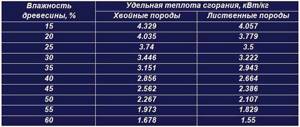
It is worth noting that the wood of raw felled poplar and some other species is completely unsuitable for use as fuel. It is loose, contains a lot of water, so when burning it produces very little heat.
At the same time, raw birch firewood has a fairly high calorific value. In addition, raw logs made from hornbeam, ash and other dense wood species are suitable for use.
Wood species
The calorific value of firewood depends to a large extent on the type of wood. Two main categories are emphasized: coniferous and deciduous. High-quality combustion material belongs to the second group. There is also its own classification, since not all varieties are suitable for one purpose or another due to their own density.
Very often, pine needles are considered the most accessible wood. Its low price is determined not only by the popularity of spruce and pine trees, but also by its qualities. But the thing is that the heat capacity of firewood of this type is low, and there are also a lot of other disadvantages.
The needles are suitable for lighting a small fire on an outing or for intermittent heat supply if there are no other options.
The main disadvantage of conifers is the presence of a decent amount of resins. When such firewood is heated, the resin begins to expand and boil, which results in sparks and burning parts being scattered over a long distance. The resin also leads to the appearance of soot and burning, which clog the fireplace and chimney.
Deciduous
It is much more profitable to use deciduous trees. All varieties are divided into three categories, depending on their density. Soft breeds include:
They quickly burn out and therefore have little value in terms of heating the house.
Medium-density trees include:
The specific heat of combustion of birch firewood is close to that of species that are classified as hard, especially oak.
Birch is one of the top three materials used for heating
In addition to oak, the category of high-density varieties includes:
The calorific value of this type of firewood is the highest, but processing of the wood is difficult due to its high density.
Oak is another common type of fuel
The beneficial qualities of such breeds make them much more expensive, but this makes it possible to reduce the amount of material that is useful for maintaining the optimal temperature in the house.
Harmful impurities in wood
During the chemical combustion reaction, wood does not burn completely. After combustion, ash remains - that is, the unburnt part of the wood, and during the combustion process, moisture evaporates from the wood.
Ash has less effect on the combustion quality and calorific value of firewood. Its amount in any wood is the same and is about 1 percent.
But the moisture in wood can cause a lot of problems when burning it. So, immediately after cutting, wood can contain up to 50 percent moisture. Accordingly, when burning such firewood, the lion's share of the energy released with the flame can be spent simply on the evaporation of the wood moisture itself, without doing any useful work.
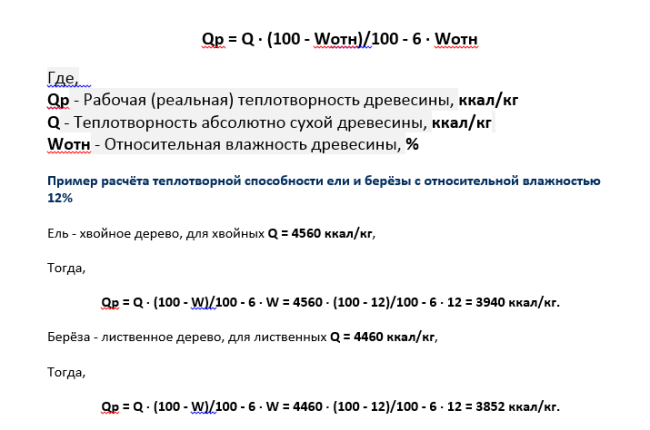
calorific value calculation
Moisture present in wood sharply reduces the calorific value of any firewood. Burning wood not only does not perform its function, but also becomes unable to maintain the required temperature during combustion. At the same time, the organic matter in the firewood does not burn completely; when such firewood burns, a large amount of smoke is released, which pollutes both the chimney and the combustion space.
What is wood moisture content and what does it affect?
A physical quantity that describes the relative amount of water contained in wood is called moisture content. Wood moisture content is measured as a percentage.
When measuring, two types of humidity can be taken into account:
- Absolute humidity is the amount of moisture that is currently contained in wood relative to completely dried wood. Such measurements are usually carried out for construction purposes.
- Relative humidity is the amount of moisture that the wood currently contains in relation to its own weight. Such calculations are made for wood used as fuel.
So, if it is written that wood has a relative humidity of 60%, then its absolute humidity will be expressed as 150%.
To calculate the calorific value of firewood at a known humidity, you can use the following formula:
Analyzing this formula, it can be established that firewood harvested from coniferous trees with a relative humidity of 12 percent will release 3940 kilocalories when burning 1 kilogram, and firewood harvested from deciduous trees with comparable humidity will release 3852 kilocalories.
To understand what a relative humidity of 12 percent is, let us explain that firewood acquires such humidity when it is dried outside for a long time.
Material selection
Even the best qualities of wood can be negated if it is selected incorrectly for a particular type of activity. For example, it makes virtually no difference what was used for the night fire during gatherings with a group of friends. Lighting a fireplace or stove in a bathhouse is a completely different matter.
We suggest you read the material about where to store firewood Plus to everything about our article today.
For any situation, materials of various thicknesses, types and characteristics are selected
For the fireplace
Home heating can be a challenge if you load your stove with unsuitable wood. This is even more dangerous when using a fireplace, since a shining log can even lead to a fire.
The unobtrusive burning of wood and the heat emanating from the fireplace are the piquancy of the guest room
For long burning and the release of a decent amount of heat, it is necessary to give preference to oak, acacia, and also birch and walnut. To clean the chimney, you can sometimes burn aspen and alder. The density of these rocks is small, but they tend to burn soot.
To equip a high temperature in the steam room of a bathhouse, the greatest heat output from wood is needed. Moreover, you can improve your relaxation conditions if you use rocks that fill the room with a good smell, without emitting harmful substances and resins.
Read also about a potbelly stove for a bathhouse with your own hands Plus everything about our article today.
The quality and type of firewood for a bath play an important role
To heat the steam room, oak and birch logs are, of course, an excellent choice. They are solid, give good heat in a limited volume and also emphasize pleasant evaporation. Linden and alder can also provide an additional healing effect. You can only use perfectly dried materials, but not older than one and a half to two years.
For barbecue
When cooking on a grill or barbecue, the main point is not the burning of wood itself, but the formation of coals. This is actually why it is not advisable to use thin, loose branches. They can be taken exclusively for lighting a fire, and then large hard logs can be added to the combustion chamber. In order for the smoke to have a special smell, it is best to use fruit wood for the barbecue. You can combine them with oak and acacia.
For a barbecue, it is not the fire that is important, but the coals and the smell of smoke.
When using different types of wood, carefully look at the size of the chocks. For example, oak will take longer to burn and smolder than an apple tree, so it makes sense to take much thicker fruit logs.
Production and use of wood fuel
This material belongs to a separate category, since it is not mined, but made in special furnaces. Craftsmen burn pre-prepared wood in large combustion chambers, which allows them to change the structure of the fuel and remove all excess moisture from it. The basic technology for producing an effective coolant has been known since ancient times. In the old days, people burned wood blanks in special deep pits, blocking access to oxygen. Modern technologies have made great strides, thanks to which multifunctional charcoal kilns are available to craftsmen.
Provided that the finished coals are stored in suitable conditions, their moisture level does not exceed 16%. Ignition of fuel is observed when heated to 200˚C. The specific heat is at a fairly high level - 7400 kcal/kg. Experts note the fact that the combustion temperature of such coal largely depends on the combustion conditions and the type of wood. For example, birch-based fuel is excellent for heating a special forge, as well as for forging metal.
If the air is supplied intensively enough, the coal will burn at a temperature of 1250˚C. As for conventional stoves and boilers, this figure will be within 900˚C. But in a barbecue, charcoal burns well at a temperature of 700˚C.
In addition to high heat transfer, this material is characterized by low ash content. Numerous positive characteristics and an affordable price have influenced the fact that charcoal is actively used for frying aromatic meat on the grill, for fireplace heating, and also for preparing delicious dishes in ovens.
Features of charcoal kilns
Those devices that heat the room using coal have their own functional and design differences. Despite the high popularity of charcoal, not everyone knows that this material does not belong to the category of minerals, but was invented by man. The combustion temperature of this fuel is 900°C, due to which a sufficient amount of heat is released.
The production of charcoal is based on specific processing of wood, due to which its structure changes and excess moisture is removed. To implement such ideas, special ovens are used, the operating principle of which is based on pyrolysis.
Such units consist of four main elements:
- Chimney.
- Capacious combustion chamber.
- Special compartment for recycling.
- Strengthened base.
Read more: DIY chimney.
Manufacturing process
When the firewood is loaded into a special chamber, then the gradual smoldering of the firewood begins. This process occurs due to the presence of a large amount of oxygen gas in the firebox, which continuously supports combustion. During this procedure, a sufficient amount of heat is released, and all excess liquid turns into steam.
All the smoke generated goes into the recycling compartment, where it burns completely and releases heat. Such a versatile charcoal kiln can perform several tasks simultaneously. Thus, with its help, high-quality charcoal is produced, and a comfortable temperature for humans is maintained in the room itself.
Experts say that the process of making such fuel is very delicate, since the slightest inattention can lead to complete combustion of the wood. The worker must promptly remove already charred workpieces from the oven.
Alternative fuel materials
The calorific value of specific types of firewood is very high, but far from the maximum potential. In order not to lose funds and space for storing heating material, today more and more attention is being paid to other options. The use of pressed briquettes is considered good.
The effectiveness of using briquettes is many times higher than that of firewood.
With similar loading volumes, solid wood ovens generate much more heat. A similar effect is possible by increasing the density of the material. In addition, there is a much, much lower percentage of moisture. Another plus is a slight formation of ash.
Briquettes and fuel pellets are made from sawdust and wood chips. By pressing waste, it is possible to create an incredibly dense fuel material that even the most suitable types of wood cannot match. At a high price per cubic meter of briquettes, the final savings will be a very large amount.
It is necessary to prepare and purchase combustion materials based on a meticulous analysis of their parameters. Only high-quality firewood can provide you with the essential heat without causing damage to your health or the heating structure itself.
Calorific value of wood - table of the calorific value of firewood
This material is intended for those owners who decide to heat their own home with solid fuel. It’s not easy to figure out which fuel is more affordable and comfortable to heat your house with. Often, owners of private buildings follow the lead of consultants from a store that sells boilers and stoves and purchase what was recommended to them in the store.
But a consultant from a store won’t live in your home; he won’t have to heat your boiler every day and listen to your family’s complaints about the cold and dampness in the premises. And therefore, consultants are considered interested persons and their arguments are listened to every once in a while.
And for yourself, once and for all, understand one point - only the owner of a private house is alone “for himself”. All others are “against him” - shabashniks, manufacturers of materials for construction, manufacturers and sellers of boilers and furnaces, Gazprom, RAO UES and so on and so forth.
So it is necessary to listen to anyone carefully, it is better to read extensive topics on all respected forums on construction and select from there, albeit bit by bit, the relevant knowledge.
Even among the flooding and mutual insults on a construction forum, you will be able to gain more functional knowledge than from a manufacturer’s marketing brochure or from consultations with a salesperson in a store.
One of these stumbling blocks, which is interpreted very differently by manufacturers of solid fuel boilers and furnaces and consultants in special stores and companies, is the indicator of the efficiency of the boiler or furnace.
Most manufacturers say the efficiency of their own boilers is 85-90 percent, although they recommend heating their own heat generators with coal and wood. Most manufacturers recommend boilers with an efficiency above 100 percent to consumers, proving this by the processes of generating gas from wood and gas-generating combustion.
And some write that in their direct combustion stoves, wood burns for up to 6-8 hours and can heat almost a palace of 3 floors and a couple of dozen rooms.
Having faith, the buyer purchases a boiler or stove marked 15 kW, hoping to use this heat generator to heat a house with an area of 150 square meters. Let his house be properly insulated, and according to SNiP, 1 kW of the heating output of a stove or boiler per 10 sq.m. should be enough. Houses.
The buyer begins to heat his own boiler with wood, but the temperature in the heating system does not want to rise even to the cherished +65C, let alone +90C. Firewood flies and flies into the combustion chamber of the boiler, and the house gradually freezes. What's the matter?
There may be several reasons for this situation, and over time we will sort them all out. In the meantime, here's the very first reason.
The manufacturer is “slightly” disingenuous, indicating the power of his own boiler or stove at 15 kW with a combustion chamber using “exemplary” firewood - firewood with a high calorific value.
And, as everyone knows, wood of various species has a wide variety of calorific values. Take a look at the table below for the calorific value of firewood:
Even if we take it for granted that all types of wood in firewood will be used with the same moisture in the combustion chamber, then look at what comes out:
- Beech or oak produce almost 1.5 times more heat in the combustion chamber than “weak” wood species - willow, willow and poplar.
- Coniferous species, being in the “average” range, still produce 40-50 percent less heat in the combustion chamber.
The manufacturer, having indicated a power of 15 kW for the calorific value of very high-calorie firewood, puts the consumer in a disadvantageous position in advance if he does not have the opportunity to purchase or prepare such firewood.
Pay attention to the table of the calorific value of firewood and understand that if you are heating with poplar cuttings or the remains of boards from construction, then you will need to choose a solid fuel boiler or stove with a rating 1.5 times higher than what is written by the manufacturer.
In other words, in order to heat a house of 150 sq.m. poplar or pine firewood, you will need to choose a boiler or stove with a capacity of 20-23 kW.
If you have questions, ask them to me, contacts are on the resource.
Best regards, Sergey Ivashko.
More on this topic on this site:
- Wood-burning boiler and coal Viadrus Hercules U22 reviews and table Boilers, which are produced under the Viadrus brand at Czech and Slovenian factories, in the Hercules variation with a capacity from 11 to 58 kW.
Home heating with wood – how real is it? When the question arises about how to heat a house in a cold winter, the average person takes paper, a pencil and a calculator and sits down.
Low wood consumption in a heating boiler - how to achieve it? If we want to describe economical solid fuel boilers, then first we need to consider a similar indicator as firewood consumption.
We purchase hot water from firewood - we use a double-circuit solid fuel boiler for long burning. Heating equipment for real estate outside the city was demonstrated to consumers in a wide range of products, including only solid fuel boilers, different in power, technical characteristics, etc.
CORRECT BOILER FIRES
There are several simple rules that must be followed in order to achieve maximum efficiency and proper operation of the heater:
- Whatever fuel is used, the amount of firewood should be at least half of the load.
- A gas generator boiler cannot be heated with insufficiently dry wood. The maximum humidity level is 20-30%. If they are damp, this will lead to a decrease in combustion temperature, as well as a drop in the efficiency level by 2-3 times.
- The efficiency that the boiler is capable of achieving decreases if the filling is incomplete. It is not recommended to fill the heater less than halfway, since as a result the wood does not burn out completely and increased formation of soot and soot occurs. As a result, the chimney and heater will have to be cleaned much more often.
- The correct length of logs is 25-35 centimeters. Firewood can be purchased in bulk in warehouse meters or by weight.
